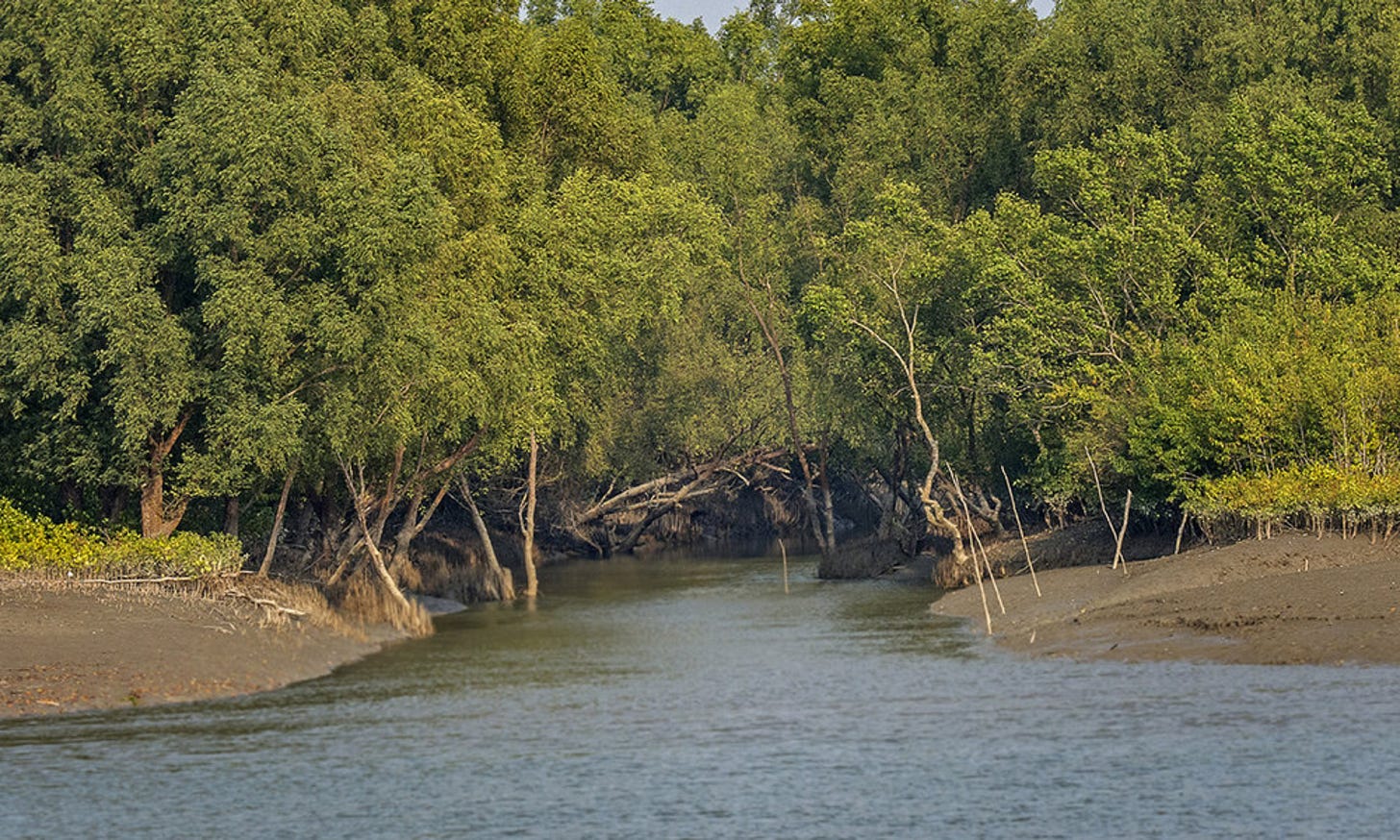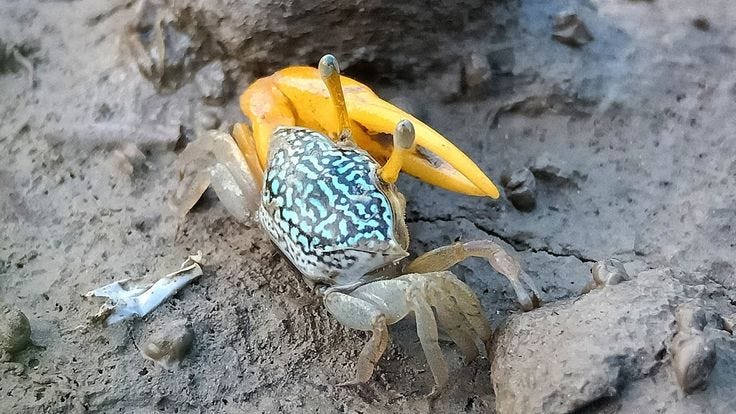In our legends it is said that the goddess Ganga’s descent from the heavens would have split the earth had Lord Shiva not tamed her torrent by tying it into his ash-smeared locks. To hear this story is to see the river in a certain way: as a heavenly braid, for instance, an immense rope of water, unfurling through a wide and thristy plain. ~The Hungry Tide by Amitav Ghosh
The Sundarbans with her mighty rivers and mysterious mangroves is the protagonist of the book, The Hungry Tide. In his inimitable style, Ghosh evokes the palpable aliveness of this liminal land where earth and water intermingle and interpenetrate. The mohona (confluence) where the Ganga, Brahmaputra and Meghna meet stretches across the horizon with the mangrove forests glimmering across the vastness. In this tide country, the surge and ebb of the tides midwifed by the moon mark people’s daily existence. Their reluctance to name the unnamable is not mere superstition but a reflection of the lived experience of the inhabitants of this land. There’s hardly a family here who has not lost someone to a tiger, a crocodile, or a snake. Or to the vagaries of the tide country. Here, life is lived in liminality, its impermanence a permanent condition, its precarity and preciousness entwined forever.
The dense and entangled mangroves with their aerial roots, leathery leaves, and impenetrable darkness do not invite exploration. The hostile terrain rebuffs at every turn, pinning the unwary in treacherous mud that sucks you in to the waist. The gnarly, subterranean roots wait to trip you face first into the glue-like sludge. If you have managed to struggle upright, the countless spiky suckers projecting upwards from the silt attack you at every step, scratching and slashing with vengeance.
This unyielding malevolence holds an attraction that defies explanation. Here, fear and awe commingle to mesmerize. When the mangroves are bathed in moonlight, their dark silhouettes floating on a shimmering silvery expanse, innumerable channels snaking their way into the inexplicable heart of this land, their sensuous enchantment become apparent. You know without a semblance of doubt that the land is alive. One has the feeling of being watched by unseen eyes at all times. The locals know this to be true.
The waters of river and sea did not intermingle evenly in this part of the delta; rather, they interpenetrated each other, creating hundreds of different ecological niches, with streams of fresh water running along the floors of some channels, creating variations of salinity and turbidity.
The unique habitat of the Sundarbans has an astonishing and dazzling variety of flora and fauna existing in their individual biodomes ranging from gigantic crocodiles to minuscule fish. This dense and mutable forest of mangroves stretching along the coast of India and Bangladesh act as a buffer against cyclones and storm surge. The mangroves not only absorb the shock of tidal surges but also hold the mudbanks together with their thick, gnarly roots preventing them from collapsing and being swept away during cyclones and floods. If not for the tide country, the plains would have been submerged long ago.
“Research has shown mangrove forests to be an excellent way to mitigate the effects of climate change, especially the storm surge accompanying cyclones, by reducing the height and speed of waves. Mangroves also help reduce greenhouse gases, as they have high rates of carbon capture.”
After Cyclone Aila slammed into the region in 2009, causing floods and mudslides, nearly 200 people lost their lives. The storm exposed the increasing dangers posed by climate change to the millions of people living in the low-lying Sundarbans, thousands of square miles of wetland jutting into the Bay of Bengal. …
Amid the rising waters, crocodiles have begun entering villages. Erratic monsoon seasons have replaced more predictable ones. And higher salinity in the water has killed off fish “as if the entire area had been crushed under the thumb,” said Ajanta Dey, a Kolkata-based conservationist.
The harm has been disproportionately felt by the most marginalized in the Sundarbans, whose population on India’s side of the border is about 4.5 million. Many live in areas reached only after dayslong boat trips.
As the brackish water around them has continued encroaching on the village’s land, people have stopped growing rice, their staple crop, because the soil is too salty. ~Facing Disastrous Floods, They Turned to Mangrove Trees for Protection
The Sundarbans
Sundarbans Reserve Forest is the largest mangrove forest in the world formed by the confluence of the Ganges, Brahmaputra and Meghna Rivers in the Bay of Bengal. Four protected areas in the Sundarbans are enlisted as UNESCO World Heritage Sites, viz. Sundarbans West (Bangladesh), Sundarbans South (Bangladesh), Sundarbans East (Bangladesh) and Sundarbans National Park (India). Its channels and rivulets permeate the borders of India and Bangladesh forming a seamless, borderless region of mudbanks, mangroves, meandering rivers, and mohonas. On the river, it is easy to float into Bangladesh.
When I visited the Sundarbans more than a decade ago, I was enthralled by the archipelagoes of islands that appeared and disappeared with the falling and rising tides, revealing dark, impenetrable depths that defy human invasion and can only be entered with respectful fear and obeisance. When the tide ebbed, the mudbanks sprang to abundant life. Fiddler crabs, a keystone species in the Sundarbans, became visible in their colorful ensemble guarding their burrows, waving their claws. Mudskippers flopped in the mud or perched on aerial roots. The silky, slippery mud was riddled with sinuous patterns and crab burrows; the surface constantly plopped and burst into bubbles like simmering soup as underground activities churned the smooth, chocolatey surface. The palpable aliveness of the land with its throbbing, pulsating, shifting, and mutating rhythms sears itself in your consciousness.
To the inhabitants, the cadence of this land flows in their veins. Our boatman spoke of a past when the mudbanks would be red with crabs. Today, he lamented, their dwindling numbers are alarming.
“Fiddler crabs are also an important part of the ecosystem of the Sundarbans. They help to aerate the soil with their burrowing, which allows oxygen to reach the roots of the mangrove trees.” ~The Fiddler’s of Sundarban: A blog on their habitat and behavior
The Sundarbans are archipelagoes of islands numbering more than 100, some no larger than sandbanks. During jowar (high tide), some of these islands become pockets floating, dark protrusions with aerial roots sticking out creating eerie apparitions. To be here is to experience this ceaseless dance between water and earth. What the water claims during jowar, she again returns with the bhata (ebb tide) but it is never quite the same. The very changeability of the land here makes the flux and flow of transformation visible to the human eye in real time. To be here is to live in liminality—between the submerged and the visible, in the formlessness of mudbanks held together by the webbed roots of the mangroves.
It never ceased to surprise me that this undulating and amorphous terrain lie just on the outskirts of the city of Kolkata barely 60 miles from my home in the Southern suburbs.
Nothing could invoke a greater sense of bewilderment than to traverse between the two habitats—one of jostling crowds and impatient cars, the other of mudbanks, mangroves, and meandering rivers. The former of concrete streets and bustling shops; the latter of networks of rivulets in endless entanglement. The former run by electric lights and clock time; the latter by the rising and setting of the sun and the tides. The Sundarbans drag you out of the trappings of modernity and thrusts you, willy-nilly, into a world of primeval rawness that takes your breath away.
I saw the milky way for the first time from a boat in the Sundarbans. Aptly called the Akash Ganga (sky river), in that humming darkness it appeared to rise almost from the tops of the mangroves and melt into the inky darkness of the firmament. The shimmering waters below and the glowing band of light above was an unfurled banner proclaiming the aliveness of the earth.









